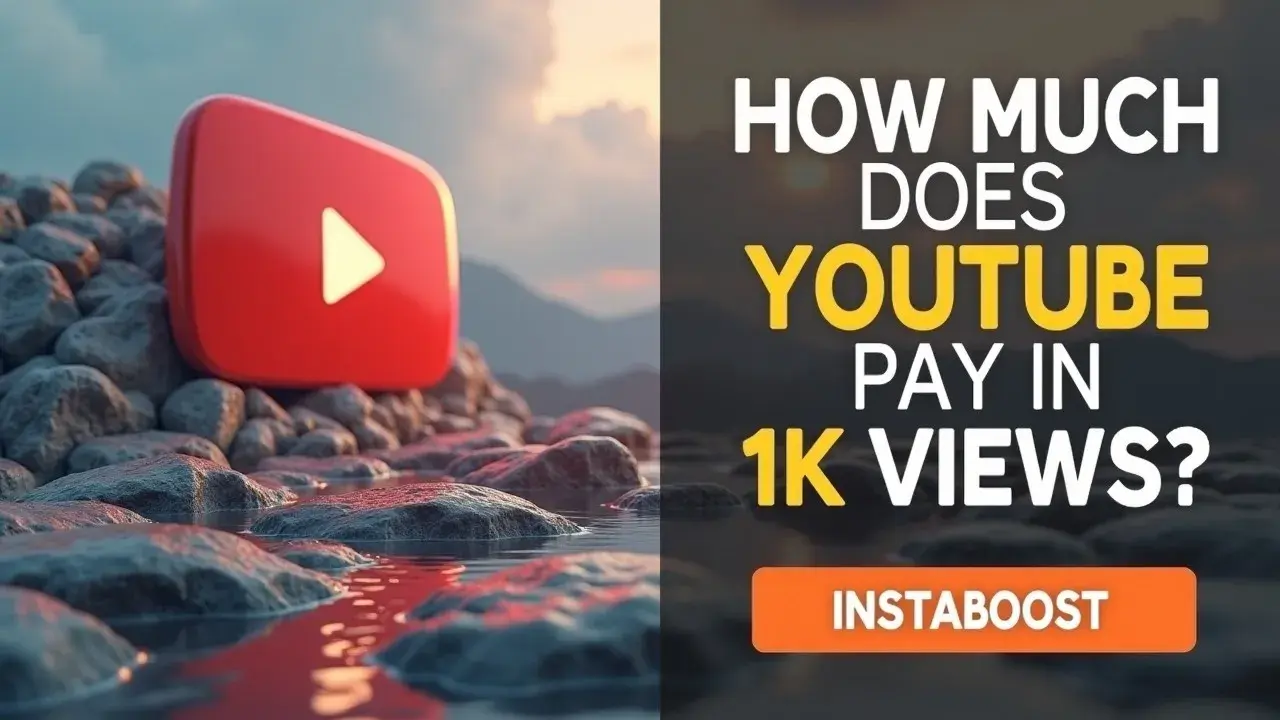How Much Does YouTube Pay for 1K Views?
Payout for 1K views varies with topic alignment, audience match, and watch time. Strong retention and clean targeting tend to stabilize the rate, while inconsistent engagement can suppress it. Expect a small lift after the first hour, then benchmark against similar videos to see true patterns. Consistent uploads and clear themes turn early 1K-view results into more reliable revenue signals and help refine what to produce next.
Why the Same 1,000 Views Can Pay Very Different Amounts
The honest shortcut is this: payout isn’t about views alone. It’s about the kind of attention those views represent. When people ask how much YouTube pays for 1K views, they’re really asking about CPM and RPM, and both are driven by topic, audience, watch time, and how advertisers bid against your niche. A finance explainer with high retention and viewers in Tier 1 countries can earn several times more than a humor short with quick swipes, even at the same view count. That’s because advertisers pay for intent and context, and YouTube favors videos that hold people. If you’re testing your channel economics, match your content to clear search intent, like “YouTube monetization rates” or “RPM vs CPM,” then pair the upload with early momentum; creators who grow your YouTube audience in aligned communities tend to see more stable RPM because the traffic is qualified.
Target promotion to relevant communities, add a small spend with a reputable ads manager or a creator collab for qualified traffic, and use a comment prompt that sparks real replies. These signals help the algorithm find paying demand. Keep analytics clean. Segment Shorts vs long-form, exclude spikes from untargeted sources, and compare RPM across similar videos instead of the whole channel. A smart path is to publish on a steady cadence and keep iterating on retention hooks in the first 30 – 60 seconds. Even a modest lift in average view duration can stabilize RPM more than chasing raw clicks.
If you use paid accelerants, add safeguards like tight geo and interest targeting, frequency caps, and a testing loop that measures watch time and end-screen CTR, not just cost per view. The non-obvious insight is simple. 1K views is a unit of distribution, but revenue comes from qualified minutes. Optimize for minutes, and the money per thousand views follows.

Why Advertisers Pay You Differently
Every failure gave me sharper instincts than any win. The first thing I learned is that when people ask how much YouTube pays for 1K views, they’re really chasing CPM and RPM, but those numbers only solidify once you earn credible intent. Advertisers don’t buy views. They buy likelihood – attention, consideration, and action inside specific niches. A 5-minute video with 70% retention, mid-roll-safe pacing, and comments that show real problem – solution interest can command higher bids than a viral short with loose intent. That’s why finance, B2B software, and health pros often see stronger RPM than broad entertainment.
If you want a reliable answer for “1,000 views,” anchor your estimate in your niche, your audience’s buyer stage, and your watch-time curve. Smart, targeted promotion from reputable channels or creator collabs can accelerate the right signals – longer sessions, saves, and qualified clicks – so the auction treats your inventory as premium. Pair that with clean analytics, pinned CTAs matched to viewer intent, and a testing loop on titles and hooks to keep early retention above the wobble zone, and make sure growth tactics don’t dilute intent when you get more YouTube subscribers by comparing lift in RPM, not just sub counts.
Even small paid boosts work when they’re matched to fit and measured against lift in RPM, not just vanity views. One non-obvious insight: comments that include brand or comparison keywords, like “best budgeting app vs X,” tend to correlate with higher advertiser bids later, because your video becomes a proxy for high-intent queries in the auction. Calibrate expectations by comparing RPM on similar videos in your own library over 30 days. “1,000 views” is a signal, not a paycheck, until your attention quality is consistent.
Aim Your Content at Intent, Not Mass
Every scalable result I’ve seen comes from a simple shift: stop chasing 1,000 generic views and build for a thousand high-intent sessions that advertisers compete to reach. If you’re asking how much YouTube pays for 1K views, the practical move is to choose a moneyed niche and shape topics to capture actions, not just eyeballs. Comparisons, “how to choose,” teardown reviews, and ROI stories tend to earn higher CPM and RPM because they signal purchase proximity. Build each video around one qualified search term and a promise the audience actually wants fulfilled.
Then protect that promise with ruthless retention – clear hooks, fast context, pattern breaks, and visual resets at the exact drop-off timestamps. Pair that with real comments and creator collabs to lift session quality, and use targeted promotion only from reputable sources matched to your niche, including likes that improve watch metrics when you need a controlled lift to early engagement signals. The right early momentum helps YouTube find lookalike viewers instead of pushing you into cheap traffic. Keep analytics clean. Separate organic and paid. Tag placements.
Run a weekly testing loop on titles, thumbnails, and intros, while keeping the content angle locked so you test one leverage point at a time. If you add affiliates or lead magnets that fit intent, you compound revenue beyond AdSense, which makes the same 1K views far more valuable without relying on viral spikes. The non-obvious insight is you don’t need broader reach – you need tighter eligibility. When your topic, audience, and behavior data align, advertisers bid with confidence, your RPM stabilizes, and each thousand views becomes a dependable unit you can scale with consistent uploads and small, measured upgrades.
Stop Worshipping Averages: Calibrate to Buyer Signals
Let’s stop acting like the algorithm owes us anything. If you’re trying to estimate how much YouTube pays for 1K views, treat averages like weather reports – useful context, not a contract. The platform favors videos that help advertisers win micro-moments, so your real lever is shaping watch behavior that signals qualified intent. Choose topics where viewers arrive with a job to be done and leave with a clear next step. Comparisons and “how to choose” pieces still work, and precision helps.
Brand tiers, price bands, and specific use cases attract the right bids. Pair that with retention signals. Front-load relevance, cut dead air by the 30-second mark, and get your key proof point in before the first mid-roll. Early momentum matters, so use targeted promotion from reputable newsletters, niche subreddits, and creator collabs that already aggregate your buyer, and fold in tactics you’ve seen work to get noticed faster on YouTube. Measure it cleanly with unique links and annotations. If you test paid boosts, buy only from qualified sources, cap spend to validate CTR and watch time, and shut down anything that inflates impressions without comments from real accounts.
RPM rises when your traffic mix tilts toward high-value geos, age bands with spending power, and search-led sessions. Aim to rank for a specific product-line query instead of a broad “best X.” Comments like “which model should I pick?” are a signal. Reply fast, pin clarifications, and shape the next video around that friction. Treat every upload as a loop. Hypothesize the buyer moment, craft the hook to match it, and audit analytics for view-through, session depth, and conversion proxy events. Do this and your 1K views stop being random and start becoming inventory advertisers compete to fund.
Ship Small, Learn Fast, Raise Your Rate
If you feel the urge to act, take it as your cue. Ship a tight video this week, then use the data to price your next 1K views higher. Treat the first 48 hours like a lab and watch CTR, average view duration, and the audience retention graph to spot the drop that’s taxing your RPM. Add intent builders – comparisons, how to choose, teardown reviews – and pair them with clean analytics, real comments you actually respond to, and creator collabs that share buyer overlap rather than just follower counts. If you amplify with paid promotion, choose reputable, interest‑matched placements and cap budgets around early momentum, and remember that distribution can include deliberate off‑platform boosts that grow your channel via content sharing without distorting your retention signal.
The aim is qualified sessions that lift CPM, not cheap impressions that sandbag your rate. Use chapters and pinned links to capture action without cutting watch time, and test end‑screen layouts until you find a repeatable path that keeps viewers inside your higher‑value cluster. A/B test thumbnails for clarity instead of clickbait, and refresh the worst performers. Improving hook integrity raises retention and advertiser confidence. Build a weekly testing loop: change one variable per upload, benchmark against your last three videos in the same niche, and log how tweaks affect RPM for search vs suggested. As patterns stabilize, expand with creator partnerships and targeted newsletters where purchase proximity is obvious. The practical answer to “how much does YouTube pay for 1K views” is that you can move that number when your content, audience, and timing align. Consistency turns 1K views into a reliable revenue signal, and smart inputs – fit‑to‑intent topics, reputable promotion, and disciplined measurement – compound into a rate advertisers compete to fund.















